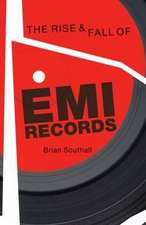Organizations as Learning Systems: Living Composition as an Enabling Infrastructure: Advanced Series in Management, cartea 4
Autor Marjatta Maulaen Limba Engleză Hardback – 26 mar 2006
The living composition model has multiple implications for managers, consultants, and academics. It helps to identify the characteristics and development potential of the enabling structures of an organization, and to evaluate various development methods and activities in a larger framework. The sources of organizational learning and renewal are diverse and difficult to understand. This book shows how organizational learning and renewal can be explained by the theory of self-producing systems.
Preț: 901.27 lei
Preț vechi: 1170.48 lei
-23% Nou
Puncte Express: 1352
Preț estimativ în valută:
172.50€ • 179.41$ • 144.56£
172.50€ • 179.41$ • 144.56£
Carte tipărită la comandă
Livrare economică 14-28 martie
Preluare comenzi: 021 569.72.76
Specificații
ISBN-13: 9780080439198
ISBN-10: 0080439195
Pagini: 261
Dimensiuni: 164 x 241 x 21 mm
Greutate: 0.54 kg
Editura: Emerald Group Publishing Limited
Seria Advanced Series in Management
ISBN-10: 0080439195
Pagini: 261
Dimensiuni: 164 x 241 x 21 mm
Greutate: 0.54 kg
Editura: Emerald Group Publishing Limited
Seria Advanced Series in Management
Public țintă
Researchers and academics.Cuprins
INTRODUCTION. A Structured Model of Living Composition- the Goal of This Book. How to Improve Survival and Success? The Question of Creativity and Efficiency. Five Dilemmas of Learning and Knowledge: The Importance of Underlying Structures. Guide to Reading This Book. Summary. LEARNING AND EVOLVING ORGANIZATION. Learning as a Source of Strategic Advantages. Adaptation, Incremental Learning, and Imitation. Learning Organization. Organization as an Interpretation System. Organization as a System of Knowing. Resource-Based, Knowledge-Based, and Competence-Based Views of Learning and Renewal. Organizational Ecology. Summary. UNDERLYING STRUCTURES AND DYNAMICS. Earlier Approaches to Control, Self-Organization, and Emergence. Structural Aspects of Strategy. Consistency of Underlying Structure. Summary. ORGANIZATION AS A SYSTEM. Open System, Contingency Theory, System Dynamics, and Network Approaches. Theories about Complexity and Chaos. Summary. HOW TO APPLY THE PRINCIPLES OF SELF-PRODUCTION TO ORGANIZATIONS. Organization as a Living (Self-Producing, Autopoietic) System. Reality and Knowledge in Organizations. Knowledge-Related Concepts in Organizational Autopoiesis. Specific Questions about Applying Autopoiesis Theory to Organizations. Summary. THE LIVING COMPOSITION MODEL. Basic Principles. The Definition of the Living Composition Model. Summary. STRATEGIC COMPONENTS OF A LIVING ORGANIZATION. Identity. Perception of the Environment. Strategy. Knowledge and Knowledge Management. Boundary Elements. Interactive Processes and Communication. Triggers (Exposure to Triggers). Experimentation. Internal Standards, Processes, and Communication. Information and Communication Systems. Summary. TWO MAJOR KNOWLEDGE FLOWS – 'SENSING' AND 'MEMORY'. Openness and Closure. 'Sensing' - Interactive Openness. 'Memory' and Self-Referentiality. Linkage Between 'Sensing' and 'Memory'. Summary. FOUR PARALLEL KNOWLEDGE PROCESSES. The Conventional Division Between Tacit and Explicit Knowledge. Four Parallel Knowledge Processes. Implications of Four Parallel Knowledge Processes. Summary. INTRODUCTION TO THE CASES. The Purpose of the Cases. Management Consulting Industry. Introduction to the Case Companies. ARTHUR ANDERSEN (BUSINESS CONSULTING). The Srategic Components of Arthur Andersen (Business Consulting). Arthur Andersen (Business Consulting) as a Living Organization. ARTHUR D. LITTLE (EUROPE). The Strategic Components of Arthur D. Little (Europe). Arthur D. Little (Europe) as a Living Organization. ERNST &YOUNG (MANAGEMENT CONSULTING). The Strategic Components of Ernst &Young (Management Consulting). Ernst &Young (Management Consulting) as a Living Organization. THE KAOSPILOTS &KAOSMANAGEMENT. The Strategic Components of the Kaospilots And Kaosmanagement. The Kaospilots and Kaosmanagement as a Living Organization. SUMMARY OF APPLYING THE LIVING COMPOSITION MODEL TO CASE ORGANIZATIONS. Strategic Components of the Case Firms. Major Knowledge Flows of the Case Firms. IMPROVING LIVING ORGANIZATIONS. Proactive and Passive Approaches. Consistency/Intentionality Platforms. Evolution Models. Six Steps for Improving a Living Composition. Summary. CONCLUSIONS. Summary of the Living Composition Model. Re-Framing of Control and Creativity in Light of the Living Composition Model. Reframing the Five Dilemmas. Living Composition - Managerial Implications. Living Composition - Theoretical Implications and Suggestions for Further Research. Living Composition - Implications for Teaching. REFERENCES. APPENDICES














